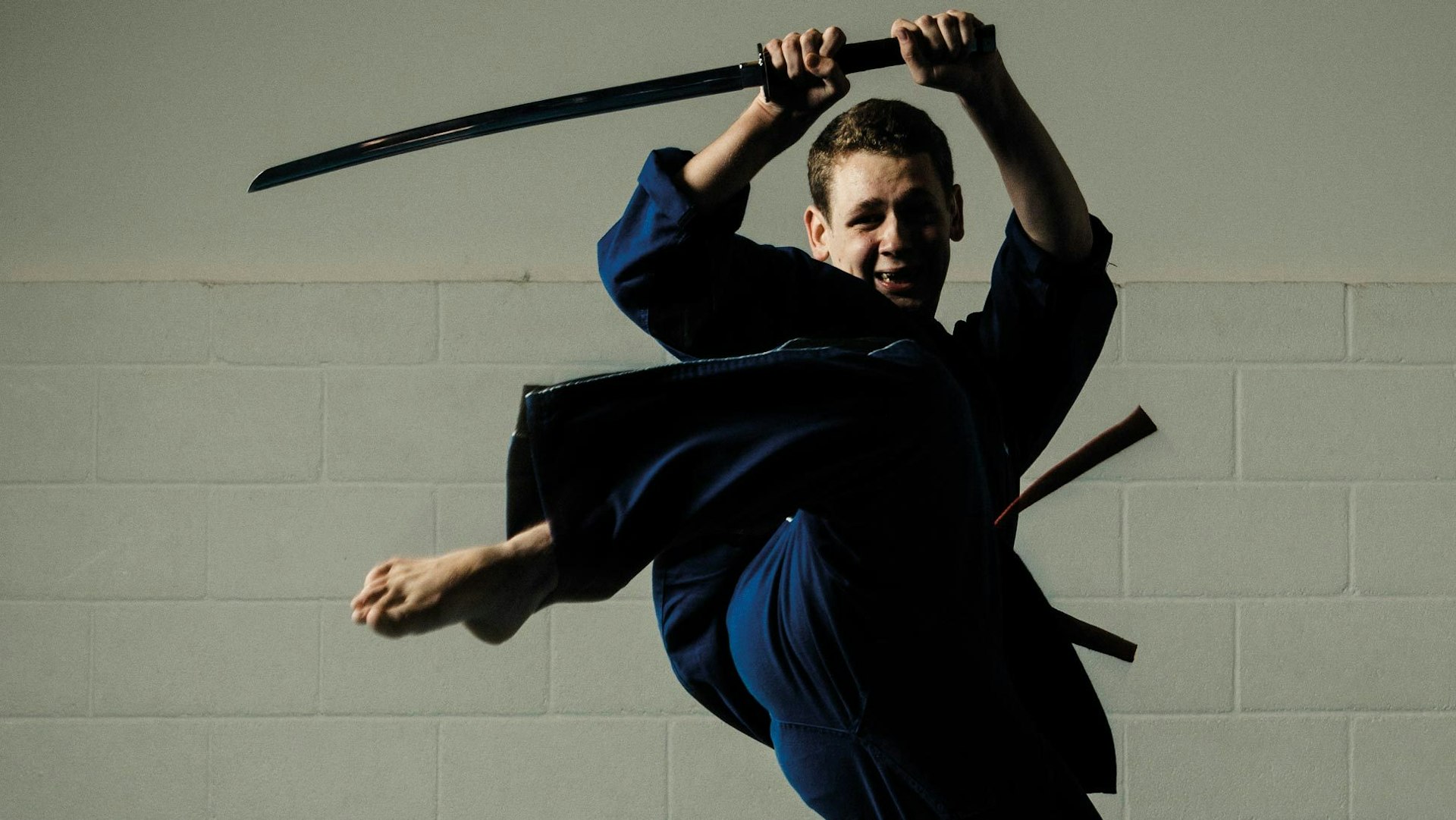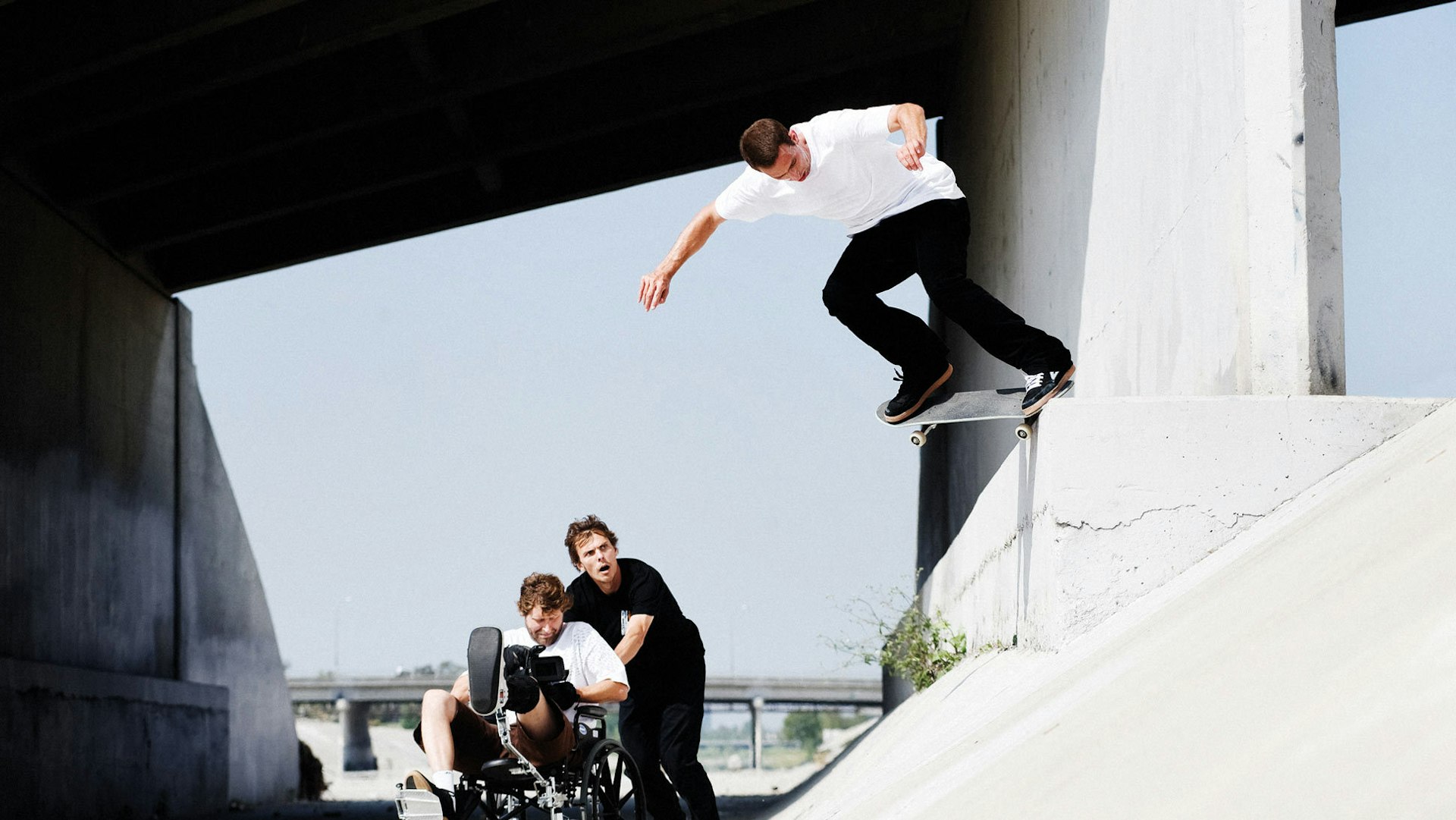
Musical Forms
- Text by Ed Andrews
- Photography by Greg Funnell
“I was a kid like anyone else, watching Power Rangers, Teenage Mutant Ninja Turtles and Jackie Chan, and from then on I just wanted to do martial arts,” explains twenty-one-year-old Joe Hallett from the jig-sawed matting of the Infinity Martial Arts centre, a dōjō he helped set up in the West Country town of Yeovil, England. “When I was eight years old, I saw a video of Bruce Lee’s nunchaku routine. Seeing him playing with this cool weapon made me really want to have a go!”
Just after Joe recounts the path that brought him here, he launches into an acrobatic routine set to a soundtrack of frantic dance tunes blasting from the gym’s sound system. He busts out a few off-axis flips, inexplicably launched from what appears to be a quick flick of the feet. Next, sparkly blue and silver nunchakus are spinning, twirling, darting around his hands, arms and body before no-handed cartwheels flash his purple sprig of hair. The performance continues with lofty flying kicks that involve a samurai sword and devastating aerial and floor strikes with a six-foot bamboo staff, all powered out with effortless precision and poise from his stocky, compact frame.
These acrobatic tricks are just a small part of Joe’s chosen discipline of musical forms, a niche sport of competitive martial arts demonstrations that attracts a small but truly dedicated following. “It’s entertainment. It’s all about what looks good and not what will work in a fight,” says Joe, the sweat beading on his forehead.
***
Musical forms, as an activity and sport, harks back to highly technical, choreographed displays known as kata in traditional Japanese martial arts, or ‘forms’ in non-Japanese disciplines. It can be performed with or without martial arts implements, like bo staffs, nanchaku and swords, in which case it’s referred to as ‘musical weapons’.
In the early 1980s, innovators such as American taekwondo master Jhoon Rhee and Montreal-based karate expert Jean Frenette started putting some of the first forms to music, and began experimenting with acrobatic tricks. These ‘musical forms’ grew in popularity at shows and competitions thanks to their crowd-pleasing appeal.
As is inevitable with any burgeoning sport, the next generation began the competitive claiming of ‘firsts’ and in the spirit of one-upmanship things progressed at a rapid pace. A landmark moment came in 1994, when five-times international forms champion and Jhoon Rhee student Carmichael Simon landed the first 720 hook kick in a routine. Another big pioneer was Hollywood-based martial artist, stuntman and one-time Blue Power Ranger Michael Chaturantabut who in 2002 developed the Xtreme Martial Arts (XMA) brand – a training programme that focuses on acrobatic ‘tricking’ to music, and today boasts over 1300 XMA-licensed schools worldwide.
Nowadays, competitions like the North American Sport Karate Association’s US Open and the CIMAC and ISKA Championships in Europe feature musical forms and musical weapon forms contests -and it’s a surreal sight. Competitors perform a jaw-dropping minute-long acrobatic routine avec their choice of sparkly bō staffs, tonfas, kamas, swords and nunchaku to a soundtrack of heavy, helium-voiced trance and dressed in outfits ranging from traditional karate suits to something straight out of a Manga cartoon – all performed with the upmost deadpan determination in search of a winning score from the judges.
As you’d expect, mainstream it is not. In the UK, multiple British, European and World Musical Forms Champion Hallett is just one of five musical forms instructors in the country, and has students travelling from across the UK to train with him.
Back in Joe’s trophy-lined dōjō – the martial arts centre he founded with his older sister Ruth Hallett in 2007 – the lesson gets underway as a dozen boys ranging from the ages of ten to sixteen temporarily ditch their youthful unruliness and start warming up. Students are encouraged to do their own thing but shuttle runs, cartwheels and explosive press-ups feature heavily, along with stretches that would make the average athlete wince.
A fourteen-year-old student called Connor Green (but known as CJ) begins a weapons-free forms routine to a soundtrack of pumping plastic pop – but only after Joe instructs him to take his bright spotted socks off. He mixes in a fluid combo of punches, kicks, flips and lightning-fast chops known as knifehand strikes, delivering an aggressive ‘Hah!’ with every strike. “First is the introduction with slow hand combinations that build up,” Joe explains. “That’s usually ten to fifteen seconds of the routine. Then you work in the opening high-energy trick or flip. Then you get faster for the next thirty seconds then the finale, the biggest trick, and finish on a high. That’s why people use dance music for their routines because it’s fast and full of build-ups.”
As we talk, another student, sixteen-year-old Matt Lightfoot, takes to the sprung floor – a trampoline style area giving students extra air time to learn their tricks – and practices a routine that involves a spinning-hook-kick-to-cartwheel-to-flashkick (a stylish backflip with one leg extended and the other tucked in), before throwing in another backflip while grabbing both sets of toes in a semi-pike position.
“I was gobsmacked by some of the moves I saw when I first got here,” remarks Richard McHugh, a thirty-one-year-old Air Engineer in the Royal Navy who helps instruct the more traditional parts of the forms routines and, as a 3rd Dan Black Belt, boasts years of experience. “I’d seen some of it before, but Joe’s lot here are very, very good at it. They train hard and they work hard on their routines and that’s the essence of martial arts: self-discipline and trying your best.”
This dedicated, work-hard ethos is pivotal. Students put in up to ten hours a week at the dōjō, learning the more traditional
moves by rote and doing plyometric drills to build up the explosive muscle power required for the acrobatic moves – with the sort of flips Matt demonstrates taking years of training to even attempt. This is on top of other fitness training every day and, of course, tireless drilling of their routines at home, in the garden, playground, wherever.
Joe’s focus on the sport is at the tunnel-vision end of the spectrum. “There is not a day I don’t think about it,” he admits. “If I’m not training, I’m watching musical forms on YouTube, and if I am not doing that, I’m watching movies like The Matrix, trying to get new ideas for choreography. You have to sleep, eat and breathe musical forms to be the best, but it’s all worth it after you walk off the matted area and hear the roar from the crowd. Nothing ever comes close to that buzz.”
Despite the obvious physical benefits of a fit and healthy lifestyle, some may be alarmed by the sight of a child wielding a potentially deadly weapon as a hobby. Have they ever faced criticism? “It’s the complete opposite of that stereotype that you don’t enrol your kid into martial arts because they just learn to beat people up,” remarks Joe, never straying from promoting the benefits of the sport he so clearly loves. “Parents are willing to enrol them because they learn respect, discipline and self-confidence – I have parents phone me up for classes because their kids are being bullied. And when it comes to weapons, you learn the basics blocks and strikes, but it’s about learning a creative style – the stuff you see in comic books and the movies these days. And anyone who ever gets a weapon put in their hands gets rules: never use this on anyone and you never get it out [outside the dōjō] and show off.”
The way in which musical forms, and martial arts in general, can help kids navigate the awkwardness of adolescence is certainly not lost on one of Joe’s students, sixteen-year-old Connor Allen. “The reason I started martial arts was because I was being bullied,” explains the softly spoken Connor, cutting the air in a surgical yet ferocious manner with a bō staff and then a (blunted) katana blade – his specialist weapons of choice. “It has shown me that you can stand up for yourself and you don’t have to walk on eggshells around everyone.”
“People often associate musical forms with things like The Karate Kid, you know the crane kick and stuff,” he adds, acknowledging that his hobby is often misunderstood. “But musical forms is more artistic and creative [than other martial arts] and there’s not necessarily any right or wrong way to do something. It’s quite hard to explain that to people, though, so the best thing to do is show them a video. And they usually say, ‘Wow, that’s cool. I’d love to be able to do that!’”
As our afternoon visit goes on, it becomes clear that Joe’s biggest motivation is promoting musical forms to the wider world. He explains the finer points of tricks and judging criteria with brimming enthusiasm; urges his students to go big for the camera; and keenly offers the photographer Greg tips on how to get the best action shots. As part of this PR mission, he’s founded his own exhibition stunt team, Team Resurrection, who perform for public shows, films and music videos.
“Musical forms and weapons need someone at the front trying to push it into the media and show these guys off,” he says. “It’s amazing and should be getting the recognition it deserves. Many martial arts tournaments don’t give much respect to forms and we’re always second best to the fighters. They need to give a good performance area, a good sound system and get good, qualified judges in. But from outside of martial arts, all we’ve had are great comments from the public and surprise that they haven’t seen it more often. Some even ask why it’s not in the Olympics like rhythmic gymnastics. I could speak for hours about that but all I’ll say is ‘politics’.”
